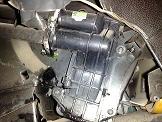- Thanks received: 1
 Mechanics manuals
all about mechanics and technological news.
Mechanics manuals
all about mechanics and technological news.
Search in MDM
Bulletin
Peugeot 206 heating leakage leakage
- Manual-Mecanica
- Author of the subject
- Offline
- Fresh Boarder
-

Less
Further
16 years 6 months before - 16 years 6 months before #5668
by manual-mecanica
FLOW IN HEATING PEUGOOT 206 PUBLISHED BY MANUAL-MECANICA
Hello everyone, I have a 206 16v and I have seen a puddle on the floor at the pedal height, then when looking for the leak I have disassembled a kind of gray cork cover that is left to the left of the central console, next to the accelerator pedal, well, the 2 input pipes and return of the refrigeration system appear and they join in a box, the problem I have in that union. According to me, I have tried to disassemble it but I don't know what I really face or how I have to do, it carries two screws and three pressure staples, by removing the 2 screws and trying to release the staples I get refrigerant liquid that I can not control and it puts everything lost. Someone can help me with this topic?
Last edition: 16 years 6 months before by .
Please connect or create account to join the conversation.
- Manual-Mecanica
- Author of the subject
- Offline
- Fresh Boarder
-

Less
Further
- Thanks received: 1
16 years 6 months before #5669
by manual-mecanica
Manual-Mecanica Response on the Re: Fuga in Peugeot 206 heating
Manuel begins by emptying the radiator, removing the lower sleeve, then hand to the work with that leak, the strange thing is not broken the heating sleeve and you have released you so for it ...
Please connect or create account to join the conversation.
- Manual-Mecanica
- Author of the subject
- Offline
- Fresh Boarder
-

Less
Further
- Thanks received: 1
16 years 6 months before #5670
by manual-mecanica
Manual-Mecanica Response on the Re: Fuga in Peugeot 206 heating
Hi Manuelenge, look as Emeralde Deves baciar the cooling fluid, it is the same engine and you should do it from the butterfly that is housed in the radiator, without it does not have a purge butterfly of purge you have to remove the lower hose from the radiator, it would serve you to have a caiman at hand, be eye with the valve or butterfly of purge when they are very hard they have to break and this means to change the radiator. I always take out the hose to be safer, now you will have to do when you emphas Well, you will lose engine refrigerant, a good trick to fix this in an artisanal way, if you do not occupy the heating or cold air, it is to make a bridge between these hoses and already this. If you don't save how to do the bridge or want Saver, ask me because telling you now is a bit long, okay.
Please connect or create account to join the conversation.
- Manual-Mecanica
- Author of the subject
- Offline
- Fresh Boarder
-

Less
Further
- Thanks received: 1
16 years 6 months before #5682
by manual-mecanica
Manual-Mecanica Response on the Re: Fuga in Peugeot 206 heating
Hello everyone, the escape is in the Toric Board that is just between the heating box and the input and return tubes that are next to the pedals. As comment in anterior lines the union has 2 screws, when loosening them liquid as it is normal and the solution you have already given me, my question is that it seems that it is a piece It is sealed, hey, thank you very much
- Manual-Mecanica
- Author of the subject
- Offline
- Fresh Boarder
-

Less
Further
- Thanks received: 1
16 years 6 months before #5720
by manual-mecanica
Manual-Mecanica Response on the Re: Fuga in Peugeot 206 heating
The two rubber tubes that go to the heater end in a kind of plug that fits into the pressure heater and with some retention clip. It is important to grease a little toric with Vaseline to facilitate its entry and avoid pinching them.
The heater is an entire piece, as if it were a radiator but smaller, that is, the heating radiator crankcase begins in the female of the plug where the two tubes go and ends in the aluminum nucleus of the heater, which you are stuck. The other radiator's crankcase is hidden, right on the opposite side of where the water inlet and exit tubes are and also glued to the aluminum nucleus. The heater is changed completely, (as if it were a radiator, everything goes on the left side in Casette plan, removes the screws and out).
All the best.
The heater is an entire piece, as if it were a radiator but smaller, that is, the heating radiator crankcase begins in the female of the plug where the two tubes go and ends in the aluminum nucleus of the heater, which you are stuck. The other radiator's crankcase is hidden, right on the opposite side of where the water inlet and exit tubes are and also glued to the aluminum nucleus. The heater is changed completely, (as if it were a radiator, everything goes on the left side in Casette plan, removes the screws and out).
All the best.
Please connect or create account to join the conversation.
Latest manuals













